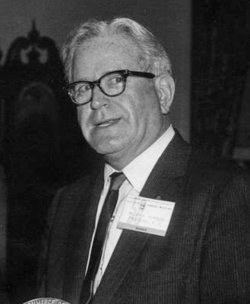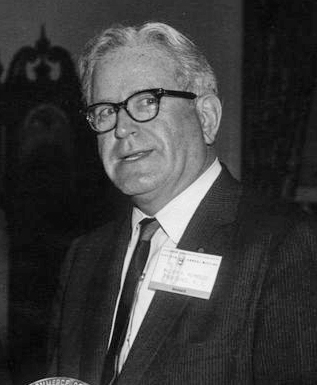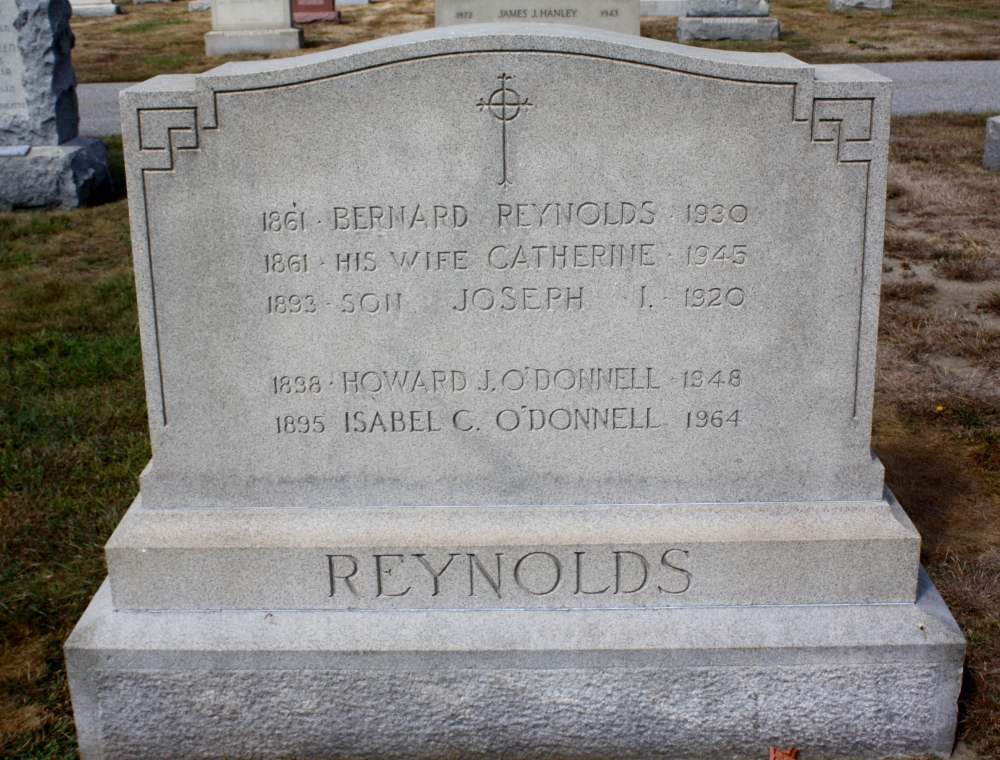from providenceri.com website:
Served January 1951 to January 1965 (Democrat)
Birthplace: Providence. During his tenure as mayor, he increased financial aid to public schools and constructed six new elementary schools. A master plan for the development of downtown Providence was prepared during his term. Although billed as a blueprint for the renewal of the downtown, it was not implemented. Providence's hurricane barrier is named in his honor. (Portrait number fifteen, located in the Aldermen's Chamber)
from the RI Heritage Hall of Fame website:
Mayor Walter H. Reynolds
(1901-1987) ~ Inducted 1985
Mayor Reynolds, known as "Barney", served seven consecutive terms as Mayor of Providence, totaling fourteen years of service. He was the City's Chief Executive during times of great accomplishment and growth. A public servant for more than thirty-five years, beginning in 1935, he received numerous national, regional, and local awards for excellence in various aspects of municipal administration. He created the Providence Human Relations Commission, and was a symbol of public integrity, with many of the City's projects as hallmarks of his tenure.
there is a photo of him with John F. Kennedy at the jfklibrary website.
partial obituary:
Walter H. "Barney" Reynolds, who as mayor of Providence from 1951 to 1965 developed a reputation as a fiscal conservative and a prudent manager, died last night at Westerly Hospital. He was 86.
A bachelor, he lived on Elmcrest Avenue in Providence until leaving office. Since then, he had made his home with a niece, Mary (Mrs. Austin) Kane, at 26 Jamestown Blvd., Narragansett.
Mr. Reynolds , Providence's 28th chief executive, was perhaps more than any of his predecessors a "career man," who came up through the ranks to the top city job.
His feat was even more remarkable because, when he was elected in a resounding victory in 1950, he became the first mayor in almost 50 years to get the job without ever having held elective office. He retired from politics when he left the mayor's office 15 years later.
An affable and quiet-spoken man, he was far from the mold of the traditional politician. He hated giving speeches and read most of his addresses from manuscripts when speeches were necessary.
When he first took office, Mayor Reynolds would arise early to walk through downtown Providence, noting what repairs were needed. He would then drop into a coffee shop for breakfast.
Before becoming mayor, Mr. Reynolds was administrative assistant to Mayor Dennis J. Roberts. He became the city's first budget officer, in 1943, and was named finance director in 1947.
When Roberts ran for governor in 1950, Mr. Reynolds entered the mayoral race against Republican Robert E. Burns. Mr. Reynolds got 56,092 votes while Burns got 23,395; he won 75 of the city's 89 polling places and carried 11 of the 13 wards.
Among the more important reforms he sponsored during his first term was the abolition of the three-man Bureau of Police and Fire. In its place was established the job of public safety commissioner. A Bureau of Licenses was established and a personnel director was named.
Accomplishments during his term included completion of the Olneyville Expressway; the setting up in 1951 of a system of state audit checks for blue parking tags to prevent the "fixing" system, and a new zoning code, which replaced a 28-year-old zoning map and ordinance.
Redevelopment projects
The first redevelopment project, which got its start under Roberts in 1947, received clearance in 1954 during Mr. Reynolds' tenure. The Willard Center project replaced a slum and run-down business area with a new shopping plaza, a new South Providence Elementary School and a playground.
One of the most important projects was the West River Industrial Park, which replaced acres of substandard tenements with an attractive site for new industry. Other projects included Point Street and the Lippitt Hill redevelopment.
The last of a series of new fire stations was completed in 1953, and the new central library addition was dedicated in 1954. During his terms, the city undertook a multimillion-dollar program of street and highway construction and renovation. As a result, Providence changed its reputation as one of the worst traffic bottlenecks along the East Coast.
In 1956, despite the fears of some City Council members and others, Mayor Reynolds won council approval for a minimum housing standards code, which resulted in substantial improvements in thousands of dwellings.
Construction of the hurricane barrier at Fox Point, prompted by the damage caused by Hurricane Carol in 1954, began during the Reynolds administration and was completed in 1966. In 1977, the City Council with the endorsement of Mayor Vincent A. Cianci Jr., named the barrier after Mr. Reynolds.
Heritage Hall of Fame
Mayor Reynolds received many awards for excellence in municipal administration during his seven consecutive terms and has been credited with establishing the Providence Human Relations Commission. He was inducted into the Rhode Island Heritage Hall of Fame in 1985.
In 1959, Mayor Reynolds was awarded two honorary doctorates in recognition of his civic leadership, one from Brown University and the other from Bryant College. In 1976, he was honored by the state Senate with a citation for his "major contributions to good government" and, in 1984, he was named "Man of the Year" by the Friendly Sons of St. Patrick.
In 1981, Mayor Cianci criticized Mr. Reynolds for taking an antique desk worth "thousands of dollars" with him when he left City Hall 16 years earlier.
Mr. Reynolds confirmed that he took the desk when he retired from office and politics in 1965. "I certainly did, but the City Council gave it to me," he said.
Mr. Reynolds said he sat at the desk for 24 years - 10 years as an aide to Roberts and 14 years as mayor - and that the council's decision to give him the desk was a gesture of respect.
Born on Federal Hill
Mr. Reynolds was born at 167 Wood St., in the "Irish End" of Federal Hill, a son of the late Bernard and Catherine (O'Connell) Reynolds. He lived in the little frame house until 1955, when he bought a home at 25 Elmcrest Ave., which he shared with his sister, the late Isabel O'Donnell.
He attended St. Mary's Elementary School, the old English High School and then the former St. Mary's Commercial High School. He began work for the Western Electric Co. in 1922 and was with that company until 1933.
He was a communicant of St. Mary's Church until he moved to Elmcrest Avenue and became a member of St. Augustine's parish.
Although he was quiet and restrained by nature, Mayor Reynolds had a rollicking and sometimes barbed sense of humor, but he could also turn the barb on himself.
He once was interviewed by Journal-Bulletin reporters in a radio press conference and was quizzed about the operation of the city's government. Time ran out and the program went off the air just as an interviewer asked him this question:
"What do you think your major accomplishment has been so far in office?"
Mayor Reynolds , knowing that the program was off the air, grinned broadly and said: "I raised my salary from $9,000 to $15,000 a year]"
He leaves 9 nieces and nephews and 23 grandnieces and grandnephews.
from providenceri.com website:
Served January 1951 to January 1965 (Democrat)
Birthplace: Providence. During his tenure as mayor, he increased financial aid to public schools and constructed six new elementary schools. A master plan for the development of downtown Providence was prepared during his term. Although billed as a blueprint for the renewal of the downtown, it was not implemented. Providence's hurricane barrier is named in his honor. (Portrait number fifteen, located in the Aldermen's Chamber)
from the RI Heritage Hall of Fame website:
Mayor Walter H. Reynolds
(1901-1987) ~ Inducted 1985
Mayor Reynolds, known as "Barney", served seven consecutive terms as Mayor of Providence, totaling fourteen years of service. He was the City's Chief Executive during times of great accomplishment and growth. A public servant for more than thirty-five years, beginning in 1935, he received numerous national, regional, and local awards for excellence in various aspects of municipal administration. He created the Providence Human Relations Commission, and was a symbol of public integrity, with many of the City's projects as hallmarks of his tenure.
there is a photo of him with John F. Kennedy at the jfklibrary website.
partial obituary:
Walter H. "Barney" Reynolds, who as mayor of Providence from 1951 to 1965 developed a reputation as a fiscal conservative and a prudent manager, died last night at Westerly Hospital. He was 86.
A bachelor, he lived on Elmcrest Avenue in Providence until leaving office. Since then, he had made his home with a niece, Mary (Mrs. Austin) Kane, at 26 Jamestown Blvd., Narragansett.
Mr. Reynolds , Providence's 28th chief executive, was perhaps more than any of his predecessors a "career man," who came up through the ranks to the top city job.
His feat was even more remarkable because, when he was elected in a resounding victory in 1950, he became the first mayor in almost 50 years to get the job without ever having held elective office. He retired from politics when he left the mayor's office 15 years later.
An affable and quiet-spoken man, he was far from the mold of the traditional politician. He hated giving speeches and read most of his addresses from manuscripts when speeches were necessary.
When he first took office, Mayor Reynolds would arise early to walk through downtown Providence, noting what repairs were needed. He would then drop into a coffee shop for breakfast.
Before becoming mayor, Mr. Reynolds was administrative assistant to Mayor Dennis J. Roberts. He became the city's first budget officer, in 1943, and was named finance director in 1947.
When Roberts ran for governor in 1950, Mr. Reynolds entered the mayoral race against Republican Robert E. Burns. Mr. Reynolds got 56,092 votes while Burns got 23,395; he won 75 of the city's 89 polling places and carried 11 of the 13 wards.
Among the more important reforms he sponsored during his first term was the abolition of the three-man Bureau of Police and Fire. In its place was established the job of public safety commissioner. A Bureau of Licenses was established and a personnel director was named.
Accomplishments during his term included completion of the Olneyville Expressway; the setting up in 1951 of a system of state audit checks for blue parking tags to prevent the "fixing" system, and a new zoning code, which replaced a 28-year-old zoning map and ordinance.
Redevelopment projects
The first redevelopment project, which got its start under Roberts in 1947, received clearance in 1954 during Mr. Reynolds' tenure. The Willard Center project replaced a slum and run-down business area with a new shopping plaza, a new South Providence Elementary School and a playground.
One of the most important projects was the West River Industrial Park, which replaced acres of substandard tenements with an attractive site for new industry. Other projects included Point Street and the Lippitt Hill redevelopment.
The last of a series of new fire stations was completed in 1953, and the new central library addition was dedicated in 1954. During his terms, the city undertook a multimillion-dollar program of street and highway construction and renovation. As a result, Providence changed its reputation as one of the worst traffic bottlenecks along the East Coast.
In 1956, despite the fears of some City Council members and others, Mayor Reynolds won council approval for a minimum housing standards code, which resulted in substantial improvements in thousands of dwellings.
Construction of the hurricane barrier at Fox Point, prompted by the damage caused by Hurricane Carol in 1954, began during the Reynolds administration and was completed in 1966. In 1977, the City Council with the endorsement of Mayor Vincent A. Cianci Jr., named the barrier after Mr. Reynolds.
Heritage Hall of Fame
Mayor Reynolds received many awards for excellence in municipal administration during his seven consecutive terms and has been credited with establishing the Providence Human Relations Commission. He was inducted into the Rhode Island Heritage Hall of Fame in 1985.
In 1959, Mayor Reynolds was awarded two honorary doctorates in recognition of his civic leadership, one from Brown University and the other from Bryant College. In 1976, he was honored by the state Senate with a citation for his "major contributions to good government" and, in 1984, he was named "Man of the Year" by the Friendly Sons of St. Patrick.
In 1981, Mayor Cianci criticized Mr. Reynolds for taking an antique desk worth "thousands of dollars" with him when he left City Hall 16 years earlier.
Mr. Reynolds confirmed that he took the desk when he retired from office and politics in 1965. "I certainly did, but the City Council gave it to me," he said.
Mr. Reynolds said he sat at the desk for 24 years - 10 years as an aide to Roberts and 14 years as mayor - and that the council's decision to give him the desk was a gesture of respect.
Born on Federal Hill
Mr. Reynolds was born at 167 Wood St., in the "Irish End" of Federal Hill, a son of the late Bernard and Catherine (O'Connell) Reynolds. He lived in the little frame house until 1955, when he bought a home at 25 Elmcrest Ave., which he shared with his sister, the late Isabel O'Donnell.
He attended St. Mary's Elementary School, the old English High School and then the former St. Mary's Commercial High School. He began work for the Western Electric Co. in 1922 and was with that company until 1933.
He was a communicant of St. Mary's Church until he moved to Elmcrest Avenue and became a member of St. Augustine's parish.
Although he was quiet and restrained by nature, Mayor Reynolds had a rollicking and sometimes barbed sense of humor, but he could also turn the barb on himself.
He once was interviewed by Journal-Bulletin reporters in a radio press conference and was quizzed about the operation of the city's government. Time ran out and the program went off the air just as an interviewer asked him this question:
"What do you think your major accomplishment has been so far in office?"
Mayor Reynolds , knowing that the program was off the air, grinned broadly and said: "I raised my salary from $9,000 to $15,000 a year]"
He leaves 9 nieces and nephews and 23 grandnieces and grandnephews.
Family Members
Sponsored by Ancestry
Advertisement
Explore more
Sponsored by Ancestry
Advertisement








